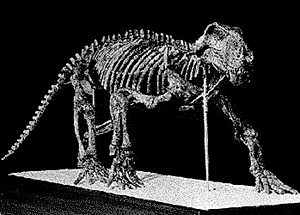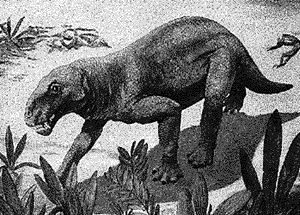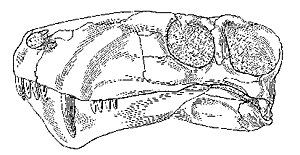 |
 |
The Gorgonopsia are synapsids, a major group of tetrapods that includes the mammals. Though more than thirty genera have been described, all gorgonopsians are now extinct. In fact, the only currently living synapsids are the mammals. It is believed that the gorgonopsians, like their living mammal relatives, were endothermic, which means they maintained a constant internal body temperature. Part of the reasoning for this is the light and agile skeleton of this group. Such a build suggests an active animal. Also, the legs are rather long compared to the size of the body -- far more so than in other animals contemporary with the Gorgonopsia. These long legs suggest they were capable of running, an activity that requires more energy.
 |
 |
Lycaenops : One of the best studied gorgonopsians is Lycaenops. You can see the mounted skeleton of this carnivore above, at left. Notice that the legs are held close to the body as they are in mammals, and not out to either side as in reptiles. At right, a reconstruction of Lycaenops in a Permian landscape. The animal was about one meter long. (Click on either of the pictures above for a larger image).
Gorgonopsians were the dominant predators of the Late Permian in southern Africa, though a few specimens have also been found in European Russia and more recently in China. This distribution is not so odd when you recall that all the continents were joined together into Pangea at this time. It is believed that the gorgonopsians preyed on dinocephalians (another group of synapsids) and on large pareiasaurs (heavy armored animals related to turtles). Some of these predators were fearsome indeed; the largest skulls found are nearly half a meter long! Some workers hypothesize that some gorgonopsians, such as Lycaenops, may have hunted in packs. Whether or not this was the case, the long agile legs of these animals would have made them able hunters.
One of the best-studied gorgonopsians is Lycaenops, a meter-long animal whose name means "wolf-face". Like a wolf's, the skull of Lycaenops (shown below) was long, low, and slender. In the drawing of the skull, you can also see another gorgonopsian character: very long canine teeth, which can be found in both the upper and lower jaw. These long sharp teeth are reminiscent of the sabre-tooth cats of the Pleistocene, and enabled Lycaenops and other gorgonopsians to stab and tear large prey.

Despite their agility and fearsome teeth, the Gorgonopsia went extinct by the end of the Permian, along with most other synapsid groups.
Visit the Synapsida pages at the Tree of Life. Or browse Jack Conrad's pages on Synapsida for additional information.

Sources:
Benton, Michael J. 1997. Vertebrate Palaeontology, 2nd ed. London: Chapman & Hall.
Carroll, R. L. 1988. Vertebrate Paleontology and Evolution. New York: W. H. Freeman.
Hopson, James A. 1994. Synapsid evolution and the radiation of non-eutherian mamals. Pp 190-219 in D. R. Prothero & R. M. Schoch (eds.) Major Features of Vertebrate Evolution. Short Courses in Paleontology 7.

